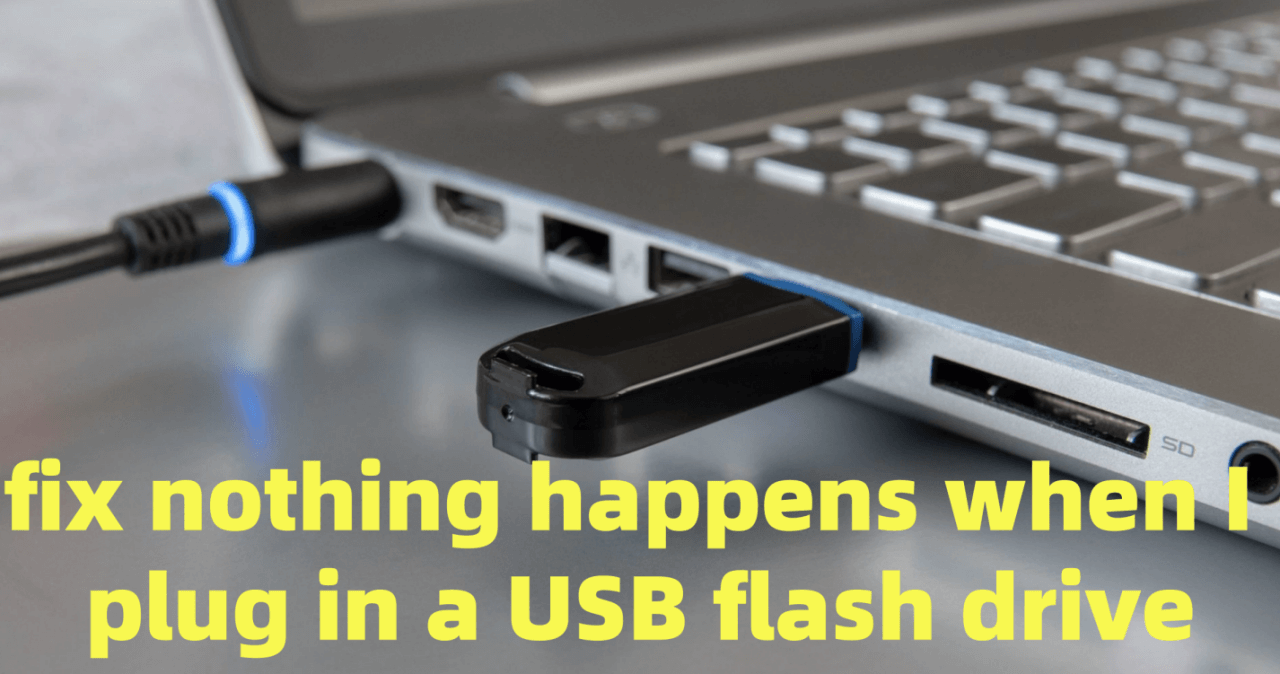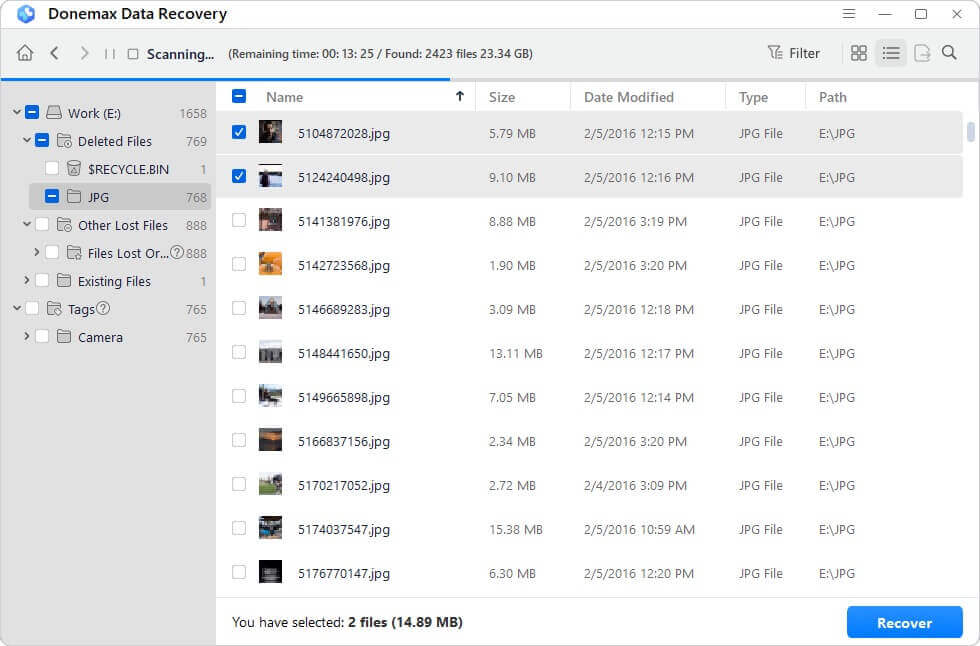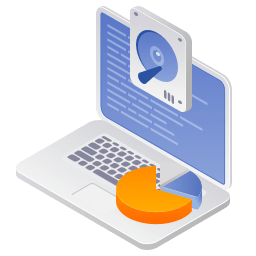Before we start: Donemax Data Recovery is a powerful data recovery program. It can help you repair damaged USB flash drive and recover deleted/formatted or inaccessible data from your USB flash drive.
PAGE CONTENT:
USB flash drives are one of the most convenient ways to transfer and store data, but occasionally, users face an issue where nothing happens when they plug in their device. The USB drive may not be detected, recognized, or may fail to show up in File Explorer or Disk Management.
This article will walk you through the common reasons behind this issue and provide step-by-step troubleshooting solutions to get your USB flash drive working again.

Common Causes of USB Flash Drive Not Being Detected
Before diving into solutions, it's essential to understand what might be causing your USB flash drive to go unrecognized:
- Faulty USB Port – The USB port itself may be damaged or have poor connectivity.
- Driver Issues – Outdated, missing, or corrupt drivers can prevent Windows or macOS from recognizing the device.
- File System Corruption – If the USB drive's file system is damaged, the operating system may not be able to read it.
- Power Supply Issues – Some USB ports may not provide enough power to detect and run the flash drive properly.
- Hardware Failure – The USB flash drive itself could be physically damaged.
- Conflicting Drive Letters – If the USB drive is assigned a letter already in use, it may not appear in File Explorer.
- Malware or Virus Infection – Malicious software can render USB storage devices unreadable.
- Operating System Glitches – Sometimes, a temporary software glitch in Windows or macOS may cause the issue.
Now that we understand the potential causes, let's move on to the solutions.
12 Solutions to Fix Nothing Happens When Plugging in a USB Flash Drive
Solution 1. Check USB Port and Try Another One
The first thing to do when your USB flash drive isn't working is to check the USB port:
- Unplug the USB drive and try inserting it into another port.
- If the drive works in another port, the original port may be faulty. Consider cleaning the port using compressed air to remove dust.
If the USB drive still doesn't work, move on to the next step.
Solution 2. Start the Computer Again
Simply starting your PC again after successful shut down can resolve temporary system faults that may be preventing the USB drive from being detected. Unplug the USB drive, restart your PC or Mac, and then plug it back in to see if it appears.
Solution 3. Check the USB Flash Drive on Another Computer
To rule out the possibility that your flash drive is damaged, plug it into another computer. If it works there, the issue is likely with your primary computer. If it doesn't work on any computer, the USB flash drive may be faulty.
Solution 4. Update or Reinstall USB Drivers (Windows Users)
Drivers act as a communication bridge between your USB flash drive and the operating system. If these drivers are outdated, missing, or corrupted, Windows may fail to recognize your USB device. This issue is common after major Windows updates or if the system has been running for a long time without driver updates.
▪️ Manually Updating USB Drivers
Comply the process below in order to manually updating the USB Drivers:
Step 1. Open Device Manager: Choose Device Manager from the list by pressing Win + X.

As an alternative, you can access Device Manager by typing its name into the Windows search box.
Step 2. Find the USB Device: Scroll down and expand the section labeled Universal Serial Bus controllers. Look for USB Mass Storage Device, Unknown Device, or anything with a yellow warning triangle.
Step 3. Update the Driver: Right-click the problematic USB device and select Update driver.

Click Search automatically for drivers.
If Windows finds an update, it will install it automatically. Check again while restarting your PC.
▪️ Reinstalling USB Drivers
If updating the drivers does not work, try uninstalling and reinstalling them:
Step 1. Open Device Manager (as mentioned above).
Step 2. Under Universal Serial Bus controllers, find the USB flash drive.
Step 3. Choose Uninstall device with a right-click on the device.

Step 4. Restart your computer after confirming the removal.
Step 5. Once the system reboots, Windows will automatically reinstall the necessary drivers.
Step 6. Plug in the USB flash drive and check if it is detected.
▪️ Downloading Drivers from the Manufacturer's Website
Sometimes, Windows does not find the latest drivers automatically. If that happens, follow these steps:
- Identify your computer's motherboard or USB chipset manufacturer:
- If you are using a laptop, you can check online about that company of the laptop.
- If you are using a desktop PC, check the motherboard model and visit the motherboard manufacturer’s website (e.g., ASUS, MSI, Gigabyte).
- Search for USB drivers:
- Go to the support section of the company website.
- Enter your laptop or motherboard model and look for USB drivers or chipset drivers.
- Download and install the latest driver:
- Follow the installation instructions provided by the manufacturer.
- Restart your computer after installing the driver.
▪️ Checking Windows Update for Driver Updates
Microsoft occasionally releases updated drivers through Windows Update. To check for updates:
- Press Win + I to open Settings.
- Go to Windows Update from System.
- Click Check for updates.
- If Windows detects any relevant driver updates, install them and restart your computer.
![Fix Nothing Happens When Plugging in a USB Flash Drive]()
Solution 5. Assign a Drive Letter (Windows Users)
If your USB drive appears in Disk Management but is not accessible in File Explorer, it may be missing a drive letter. To assign one:
Step 1. Choose Disk Management by pressing Win + X.

Step 2. Find your USB drive, which can have the label "Removable."
Step 3. Choose Change Drive Letter and Paths with a right-click.

Step 4. Select a drive letter, click Add, and then click OK.
Now check if the USB drive appears in File Explorer.
Solution 6. Format the USB Drive (If It Appears in Disk Management but Not in File Explorer)
If the USB drive is detected in Disk Management but doesn't appear in File Explorer, it may have a corrupted file system. You can format it to fix the issue, but this will erase all data.
Step 1. Open Disk Management (Win + X > Disk Management).
Step 2. Right-click the USB drive and select Format.

Step 3. Choose FAT32 (for compatibility with most devices) or NTFS (for Windows-only use).
Step 4. Click OK to format the drive.
Once formatted, check if the USB drive appears in File Explorer.
Solution 7. Run Hardware and Devices Troubleshooter (Windows Users)
Windows includes a built-in troubleshooter that can detect and fix USB-related issues:
Step 1. Press Win + R, type msdt.exe -id DeviceDiagnostic, and press Enter.

Step 2. Click Next to run the Hardware and Devices Troubleshooter.

Step 3. Follow the on-screen instructions and apply any recommended fixes.

After running the troubleshooter, restart your PC and check if the USB drive works.
Solution 8. Enable USB Device in BIOS
Sometimes, USB ports may be disabled in BIOS settings. To check:
Step 1. Restart your computer and enter BIOS/UEFI by pressing F2, F12, Delete, or Esc (varies by manufacturer) during boot-up.
Step 2. Navigate to the Advanced or Integrated Peripherals section.
Step 3. Look for USB Configuration and ensure that USB ports are enabled.

Step 4. Save changes and restart your computer.
Solution 9. Scan for Malware or Viruses
A virus or malware infection could be preventing your USB flash drive from being detected. Use Windows Defender or a third-party antivirus application to do a thorough system scan. If the scan detects threats, remove them and check if the USB drive is now recognized.
Solution 10. Try Using a Linux Live USB
If the USB drive is not working in Windows, boot into a Linux Live USB (such as Ubuntu) and see if the drive is recognized there. Sometimes, Linux can access files that Windows cannot.
Solution 11. Use a Different USB Cable or Adapter
If you're using a USB extension cable or adapter, it might be faulty. Try plugging the USB drive directly into the port without any extensions.
Solution 12. Recover Data from a Corrupted USB Drive
If your USB flash drive contains important data but is unreadable, you can use some reliable and trust worthy third-party recovery tools. These tools can help recover files from a corrupt or unreadable USB drive before formatting it.
Donemax Data Recovery is one of the best data recovery programs. It can help you recover lost data from a corrupted or inaccessible USB flash drive on Windows or macOS.
Step 1. Download and install Donemax Data Recovery on your computer and plug the USB drive into the computer.
Step 2. Open Donemax Data Recovery, select the USB flash drive to start data recovery.

Step 3. Click on Scan button to deeply scan the USB flash drive. It will find all recoverable files from the drive.

Step 4. After scan, you can check what it has found. Then preview and recover the files you need.

Donemax Data Recovery also can help you reformat corrupted USB flash drive, repair damaged USB flash drive, etc.
Conclusion
A USB flash drive not being detected may occur due to faulty ports, driver issues, file system corruption, or hardware failure. By following the troubleshooting steps outlined in this article, you can diagnose and resolve the issue effectively. If the drive is completely unresponsive even after trying multiple solutions, it may be physically damaged and require professional data recovery services.
To prevent future issues, always eject USB drives safely, avoid using damaged cables, and keep your system drivers updated. If your USB flash drive is still under warranty, consider getting a replacement from the manufacturer.
By systematically working through these fixes, you should be able to get your USB flash drive up and running again.


Donemax Data Recovery
Powerful, safe & easy-to-use data recovery software to easily and completely recover deleted, formatted, inaccessible and lost data from PC, Mac, HDD, SSD, USB drive, camera, SD card, RAID and other storage devices.
Related Articles
- Mar 17, 202510 Solutions to Fix Seagate External Hard Drive Not Mounting on Mac
- Jan 22, 2024New SSD Not Recognized By Disk Utility on Mac, Fix It Now
- Dec 18, 2024Unable to Write Data to USB Drive or SD Card on Mac? Here's How to Fix It
- Jul 02, 2024Cannot Format Samsung SSD? Fix It Now
- Dec 24, 2024Seagate External Hard Drive Shows Wrong Capacity: How to Fix It
- Dec 25, 20248 Solutions to Fix The Disk Couldn't Be Ejected Because the Finder Is Using It

Charles
Charles, who lives in Sydney, Australia, is an editor & writer of Donemax Team. He is good at writing articles related with Apple Mac computers, Windows operating systems, data recovery, data erasure, disk clone and data backup, etc. He loves reading and playing tennis in his spare time and is interested in testing new digital devices such as mobile phones, Macs, HDDs, SSDs, digital cameras, etc.

Gerhard Chou
In order to effectively solve the problems for our customers, every article and troubleshooting solution published on our website has been strictly tested and practiced. Our editors love researching and using computers and testing software, and are willing to help computer users with their problems
Hot Donemax Products

Clone hard drive with advanced clone technology or create bootable clone for Windows/Mac OS.

Completely and easily recover deleted, formatted, hidden or lost files from hard drive and external storage device.

Certified data erasure software - permanently erase data before selling or donating your disk or any digital device.
